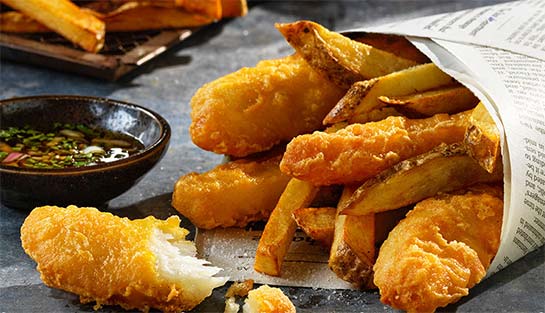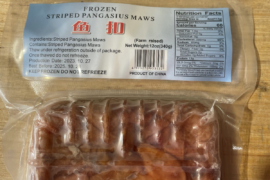Chairman Henry Demone has resumed day-to-day command of High Liner Foods, succeeding Keith Decker who held the post of president and chief executive officer for the past two years. No reason was given for Decker’s departure.
 Demone, who will remain chairman of the Lunenburg, Nova Scotia, Canada-headquartered company, previously served as chief executive from 1992-2015. During that 23-year period he spearheaded its transformation from a regional fishing and processing operation to a global seafood procurer and leading supplier of frozen seafood in North America, with sales exceeding $1 billion per annum.
Demone, who will remain chairman of the Lunenburg, Nova Scotia, Canada-headquartered company, previously served as chief executive from 1992-2015. During that 23-year period he spearheaded its transformation from a regional fishing and processing operation to a global seafood procurer and leading supplier of frozen seafood in North America, with sales exceeding $1 billion per annum.
“I am here full time with all of my energy and all of my talent to do the job as well as I can,” said 63-year-old Demone during a conference call with stock analysts and investors on August 15. “I promise you I won’t be here as long as the first time. But more seriously, we will be looking for a new ceo, and obviously the board makes that decision. In the meantime, I’m doing the job on a full-time basis, not on an interim basis.”
High Liner Foods’ retail branded products are sold throughout the United States, Canada and Mexico under the High Liner, Fisher Boy, Mirabel, Sea Cuisine and C. Wirthy labels, and are available in most grocery and club stores. The company also sells branded products to restaurants and institutions under the High Liner, Icelandic Seafood and FPI labels and is a major supplier of private label value-added seafood products to North American food retailers and foodservice distributors.
The company reported gross sales of US $508.1 million for the first half of 2017, down from $515.8 million during the like period in 2016. Results were impacted negatively in the second quarter by $3.9 million and $7.7 million declines in sales volume and value, respectively, as well as by a foreign exchange hit of $2.7 million and product recalls that led to $8.6 million in temporary paper losses during the first half of the year.
The voluntary recalls were triggered by the potential presence of undeclared milk allergen in ingredients supplied by a third party.
Paul Jewer, High Liner’s executive vice president and chief financial officer, reported that $6.7 million was added back for the purpose of calculating adjusted EBITDA for the second quarter. The second component of the $8.6 million in total estimated losses is $1.9 million related to the return of product to be reworked. This has not been added back for the purpose of calculating adjusted EBITDA, as it is expected that the seafood will be resold.
“The majority of the disruption to our business associated with the recall has subsided,” said Jewer. “We are receiving regular ingredients shipments from the supplier to rebuild inventory of recalled products, and have resumed shipment of these products to customers. We expect to recover substantially all of the estimated losses associated with the recall from the ingredient supplier.”
During the conference call, the chief operating officer confirmed that the traditional breaded and battered fish category is continuing to decline, though the pace of slippage has moderated.

Q2 Sales Volume Up
Sales volume increased in the second quarter of 2017 by 1.1 million pounds to 63.4 million pounds. This was due to higher demand in both Canadian and US markets, and 3.3 million pounds tipping the scales following the acquisition of Culver City, California-based Rubicon Resources. The unit is engaged principally in the import of farm-raised frozen shrimp from Thailand and elsewhere in Southeast Asia for distribution to private label customers.
On the negative side of the ledger, Reduced sales volume related to the actual or anticipated return of various SKUs associated with the product recall amount to 2.5 million pounds. In addition, lower scallop sales resulted from the disposition of the processing facility in Massachusetts.
Excluding the impact of these items, positive sales volume for Q2 in part reflected higher sales volume in Canadian retail and foodservice businesses, and in the US foodservice sector. A later Easter holiday (April 16, 2017, compared to March 27 in 2016) shifted a portion of the benefit associated with Lent into the second quarter of this year, compared to the full benefit being realized in the first quarter of 2016. However, this was offset by lost sales opportunities attributed to limited product availability and customer shortages as a result of the recall.
Sales increased in the second quarter of 2017 by $8 million to $232.4 million compared with results generated during the same period in 2016. Approximately 69% of the company’s operations, including sales, are denominated in US dollars. The slightly weaker Canadian dollar in the second quarter of 2017 compared to the second quarter of 2016 decreased the value of US dollar sales from Canadian dollar-denominated operations by approximately $2.9 million, relative to the conversion impact last year.
Positive Outlook
“Having returned to year-over-year organic sales volume growth, we believe continued improvement in our manufacturing operations will return the company to year-over-year earnings growth in the third and fourth quarter of 2017,” concluded Demone. “A full recovery from the product recall and the acquisition of Rubicon are expected to further strengthen our financial performance in the back half of 2017.”





